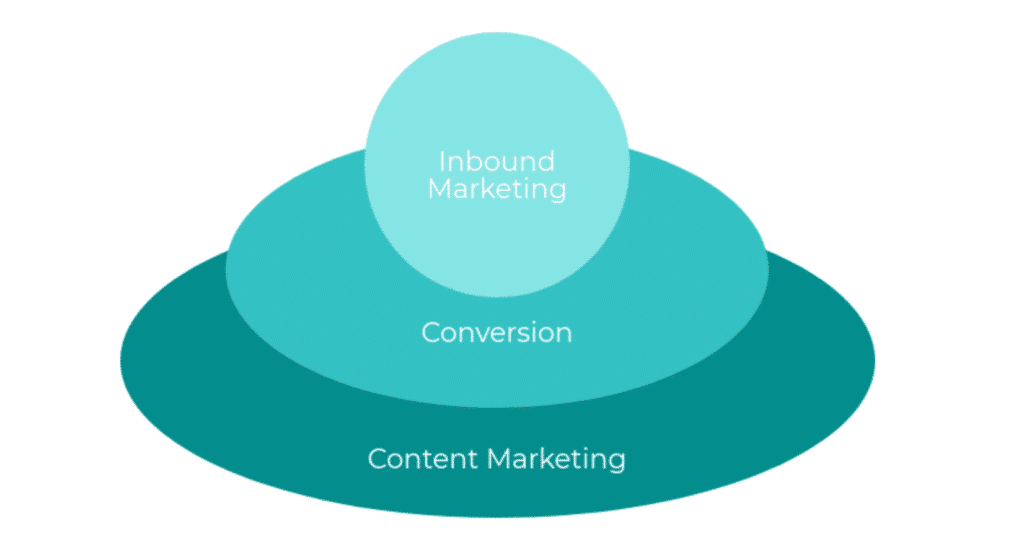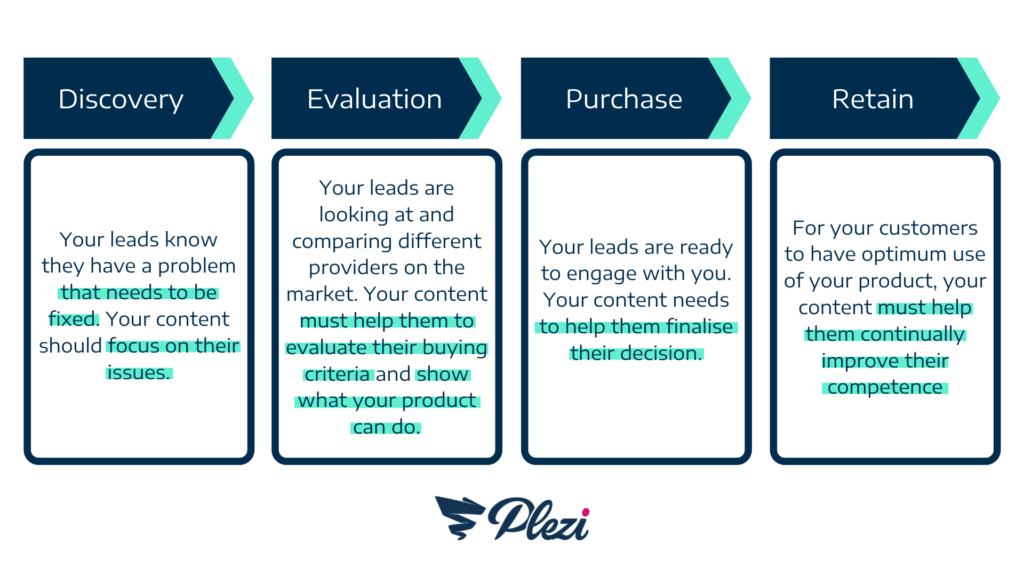What criteria do you use to assess your success as a B2B marketer?
At the end of the day, the only thing that truly matters is your ability to generate sustainable revenue for your company.
But how do you do that?
Inbound marketing is often portrayed as THE technique to use to generate leads and to move them through the funnel up until purchase. However, inbound marketing requires you have web content at each stage of the buying cycle.
So, should you just create content that your target audience might find interesting and see what happens? The reality is not that simple.
Too often, when we talk about content strategy, we think above all about the “content” and not enough about the “strategy.” But a strategy consists of both a set of actions and resources deployed to achieve a given objective.
In this article, we’ll look at how to raise the level of your content strategy.
Below, you’ll find:
- 3 levels of strategy for your content
- 3 questions to ask yourself about content marketing
- 3 actions to make your content strategy a success
 3 levels of content strategy
3 levels of content strategy
Content strategy is a recurring topic of conversation in inbound marketing. We’re always told that having an optimized content marketing strategy is essential to achieving our marketing objectives.
The problem is that we’re not always told how to market content.
As a result, many companies implement a content strategy but often with quite different objectives. Here, we’ve identified 3 different levels of content strategy.
You aim should be to reach level 3 as quickly as possible.
Level 1: Creating useful content
This is the basic starting point. The aim here is to create a blog and content to attract potential customers to your website.
Often, this first step is triggered by one of three things:
- The bandwagon effect: you’ve noticed that your competitors and a growing number of companies, in general, have started using content marketing. So, you start to simply copy what they are doing.
- The “proclamations” of influencers: you’ve read either general or specialized blogs with statements like “you have to become your own media outlet!” And so, you rush to get started without yet being aware of all the issues involved.
- The reaction that marketing departments have to the high cost of advertising or other activity involving the media.
A “content strategy” at this level is focused more on content production than on the goal you want to achieve. The risk is that you create content for the sake of doing so, without a specific objective in mind and without measuring the results. But without an objective, there is no strategy.
However, this first level lets you get into a rhythm of creating content and to deploy the necessary resources to do so. While this isn’t enough to stand out from the crowd, it’s a good place to start giving your processes some structure.
You can already put in place a number of elements key to any successful content strategy:
- A structure for creating content
- An editorial calendar
- A budget
- Resources
Level 2: Creating content that converts
The aim at this level is to take things one step further and to introduce the idea of intent.
A marketer asks themselves the following questions:
- How do we attract a visitor to our website?
- Why will someone read this content?
- Once they have read our content, what can we offer them as a next step?
At this point, you have to define your buyer personas. You also need to diversify your content offering and start creating both lead magnets and premium content (e.g. white papers).
You will integrate additional elements (e.g. calls to action, landing pages, forms) with each piece of content and define conversion objectives. You’ll also define content marketing KPIs to measure the results of your content strategy and to analyse lead acquisition.
At this level, the risk is having too narrow a focus on content topics. By doing so, you can soon end up with content that goes off in too many directions.
Level 3: Creating content aligned with an inbound marketing strategy
Now you need to add two things that were missing at the previous level: an overall vision and consistency between the different pieces of content.
For the purposes of content creation, you will create a matrix that matches a buyer persona with their position in the buying cycle.
You also now need to create content clusters to cover the different stages of the buyer’s journey for each persona. Different objectives can then be assigned to each piece of content based on these journeys.
Content distribution is automated at this level to ensure that each prospect receives content that is tailored to their personal preferences and position in the buyer’s journey.
The risk is to want to keep doing this manually. But why is that?
You are now further enhancing both your knowledge of customers and your content offering in order to create a seamless, personalized user experience. At this level, your content strategy becomes a fine-tuned machine. If you don’t send prospects the right message at the right time, you risk throwing a spanner in the works and blocking your lead in the marketing funnel.
Here you should work on the buyer’s journey and content clusters to combine content marketing with SEO. And in terms of KPIs, you need to analyse conversion rates for the different stages of the funnel.
3 key questions to ask when implementing a content strategy
Question 1: Who should create the content strategy?
In inbound marketing, the marketing department is responsible for generating a steady stream of leads who are ready to be passed to the sales team.
Marketing handles both lead generation and lead nurturing so that salespeople can focus on closing sales and customer relations.
To do this, content is used:
- To attract visitors and convert them into leads
- To move leads through the marketing funnel to purchase
- To create points of contact and opportunities for salespeople
As a result, it’s marketing who creates the content strategy and who drives conversations with leads throughout the buyer’s journey.
 Question 2: Who should the content strategy involve?
Question 2: Who should the content strategy involve?
Marketing defines the content strategy. However, this doesn’t mean that content is the exclusive domain of marketers.
When you are building buyer personas, for example, other employees, and particularly salespeople, should be invited to help define customers and generate discussion with feedback they’ve received in the field.
You can also call on colleagues from other departments to help decide on what content to create based on your sales and marketing objectives, the level the content is aimed at, and your target audience.
At Plezi, it’s pretty simple. We provide marketing solutions to marketers. So, we’re actually marketers who are targeting other marketers.
If your product is an industrial metal spinning solution, however, you are targeting a very specific audience with a high level of technical knowledge. You’ll need to involve technical staff in your content strategy if you want to ensure that you’re speaking the same language as your target audience and that you address their real pain points.
You can do this by setting up an editorial committee that meets regularly to share feedback and think about the content needs of the audience you are targeting. At Plezi, we bring together marketers, salespeople, CSMs, and management every quarter to work on our content strategy.
Question 3: Should you choose quality or consistency?
For years we’ve been told that to be truly effective at content marketing and SEO, you need to produce content on a regular basis.
So, you consistently create content, the quality of which is perhaps sometimes not what it could be. But, hey, you need to feed the machine, even if it means only creating “snackable” content.
However, this no longer really holds true.
The first reason is that, for many subjects, we’ve pretty much reached content saturation point. Sometimes thousands of pieces of content are effectively in competition for each Google query.
The competition is such that, to reach the top position in search results, the content that you create has to be of an extremely high level of quality. The 10x content methodology makes it possible to produce excellent content and ensure a sustainable SEO position.
A number of people and organizations (including Plezi) now advocate creating slow content. This means creating less content, but content that is better and which delivers more value. Since Hummingbird and Rankbrain, Google algorithms have been increasingly based on semantic analysis which favours quality content.
Varying the format of content is another major trend. Creating visual, video, and audio content lets you reach your target audience in different ways and to multiply touchpoints. At Plezi, for example, we regularly create infographics and produce webinars. Content is a lot like food: it’s all about having a balanced diet!
3 key actions to convert prospects with your content
Action 1: Use the right lead magnets
It’s pretty rare for a visitor to view one piece of content and go directly to your purchase page.
So, content should be used as an opportunity for starting a conversation as much as converting visitors.
Every time you create a piece of content, the worst thing that can happen is that the people who read it then leave your website without leaving any contact details.
To start a relationship with them, you have to make the reader want to engage with content, to take a step in your direction, and to make contact.
In order to do this though, you’ll need their contact details. But they’re unlikely to give these to you without receiving something in exchange.
To generate leads, you need to provide content that addresses one of your target audience’s pain points in a practical way.
For example, we noticed that our target customers often searched for content on buyer personas. In particular, they were looking for templates and examples to use to create their own buyer personas. So, we wrote a guide to the subject and created a “buyer persona kit” they could download.
At this stage, the idea is to initiate contact. To encourage prospects to respond, we don’t ask for a lot of information at first (e.g. name, email address, and phone number). Then, in Plezi, we use smart forms that let us qualify this prospect as we interact with them further.
Action 2: Use retargeting
Lead magnets let you initiate contact with a visitor. But what can you do about the 9 out of 10 visitors who leave your website immediately after viewing content?
Do you just let them go and cross your fingers that they come back one day?
Retargeting lets you recapture the interest of and re-engage visitors who have left your website without leaving any contact details. This can take the form of a sponsored ad on Facebook, for example.
You can start simply and use retargeting without segmentation, with one message for everyone.
But if you have two visitors who have viewed different pages on your website, it’s quite possible that they have both different profiles and expectations. You can then gradually refine this process by using different retargeting messages aimed at different audiences and based on the inbound marketing funnel.
Action 3: Use marketing automation with lead scoring
If you can re-engage a visitor, you can then send them the right content to move them further along your funnel.
And by doing this, you’ll be able to gradually build up a more detailed profile for them. If you use marketing automation software like Plezi, you can collect both the data they provide in smart forms and behavioural data using the software’s tracking feature.
At the same time, each interaction will add to a lead’s score and enable them to be segmented using tags.
You’ll then be able to provide each visitor with content that specifically matches their profile, their expectations, and their position in the buyer’s journey.
Content is a long-term investment. Implementing a content strategy takes time, organization, and resources. But if you do it right, it lets you strengthen your marketing actions and use them on a large scale. While advertising delivers peak results during a campaign, a well-executed content strategy will generate sustainable traffic to your website, leads, and most importantly, sales.







 Question 2: Who should the content strategy involve?
Question 2: Who should the content strategy involve?